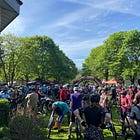“[R]eal adventures, I reflected, do not happen to people who remain at home…”—James Joyce, “An Encounter,” Dubliners.
The final set of “Rules” sent to each participant included these sweet and delicious warnings, in bold font to catch our attention: “You are responsible for your safety…In case of an emergency, call 911…Shit happens…Be prepared to rescue yourself.”
As Cycopaths are well-aware, the nanny-state has not fully invaded every nook and cranny of modern life. And the Black Fork Gravel Grinder (or “BFGG” if you like brevity) is testament to the adventure that awaits if we just heed its call.
Yvon Chouinard, the founder of Patagonia, is famous for another quote about adventure: “The word adventure has gotten overused. For me, when everything goes wrong – that’s when adventure starts.”
For the 2025 edition of the BFGG, the adventure started before anyone even crossed the starting line. Forty-nine degrees. Consistent rain leading up to and throughout the day. Wind.
As if the grueling course itself was not enough adventure.
Some readers may recall that the boy who gave us the quote at the beginning of this essay ended up playing hooky from school with some friends and was nearly assaulted by a pedophile. I don’t know if Joyce was commenting on adventure in general or just the risks of living in Dublin at that time, but it’s enough to make you ask yourself whether all this adventure is really such a great idea.
Adventure is both one of life’s greatest pleasures and an entirely subjective taste; everyone can enjoy the benefits of a little adventure — within a range of reasonable risk — if we each define what constitutes adventure for ourselves, based on our own abilities and experiences.
I personally like to pursue what my friend Tony Bunt has brilliantly called “fair-to-middling” adventures: enough to require some planning, preparation, and problem solving skills — and definitely enough for things to go wrong and for the exact outcome to be in doubt — but not enough to make my wife double-check the life insurance policy. I like for my heart rate to be elevated, but not at an unreasonable risk of flatlining.
I have to wonder, though. Am I missing a critical element in the definition of “adventure”?
The BFGG offers its adventure in a range of flavors, surely with enough variety to get almost anyone’s heart pumping. The “original” route is just over 30 miles and 4,000 feet of climbing. I personally need to start focused training in November for the May ride, and even then the climbing is daunting. The steepness of some of those hills is really just hard to convey. But the training and moderate risk involved in the whole process is part of the joy.
If that’s too fair-to-middling, there is also the option of nearly 53 miles with almost 7,000 feet of climbing. Not hard enough? OK, race it against some of the best gravel riders around and let me know how you finish. More sensible folks can always opt for the third alternative route: a beautiful 23-mile ride with “only” 2,264 feet of climbing.
This diversity has always been one of my favorite aspects of the BFGG. There are serious riders there to compete in a leg of the statewide gravel racing series. There are high school kids who participate in the Ohio youth mountain bike competitions. There are novice old folks (like me), experienced mountain bikers, and even some roadies looking to step outside of their comfort zones. Last year we chatted with a father-son duo who rode the 53-mile version on a tandem, and they were there again this year in the rain and slop. (That kind of adventure may be an acquired taste, but I’d wager it’s a life experience they won’t soon forget.)
So what did all that rain do to the course? The ride begins with a very short section down pavement on Wally Road but quickly turns up the more rustic Valley Stream Road for the first big climb. Almost immediately after the turn on to Valley Stream you encountered the first patch of mud. It was worse than I expected. Think of those spots on your favorite trail that hold water a little longer than the rest of the trail, with thick slimy mud that will grab your wheels like the Blob from the old movie. Now imagine large sections of that mess with more than 400 of your best friends riding it all at once. They call it a “gravel” route but I mostly saw mud.
This year’s Men’s Champion, Jimmy Toner, finished in 3:03:48 and the Women’s Champion, Sima Tavazoie, finished in 3:36:51. The Men’s Course Record is held by Matt Acker at 2:44:44; the Women’s Course QOM is Emily Leonard at 3:23:51. You can assume by these times that the weather slowed down even the fastest riders on the day, but those are still some very impressive times under the conditions.
It took a lot of fortitude to start the ride this year and a lot more to finish. I’m not proud of my decision, but after the first 10 miles or so I decided to finish the ride along the 23 mile route, although I had been training for the 30 mile route for months. I have to live with this decision, but as with everything in life it was a learning experience. Would I even start it again? Would I force myself to finish?
A new outlook
Who knows, but I do now have a different perspective on riding and suffering.
Only after the BFGG did I have the good fortune of reading “Submitting to the Pain” by Adam Doc Fox, here in the Cycotherapy pages. I’m pretty new to cycling and “endurance” type sports, coming from a soccer obsession that only dwindled when a combination of the pandemic and old age forced me to find another way to abuse my body. Soccer involves much suffering but it’s widely accepted as a bug, not a feature of the sport (except as a supporter of U.S. soccer, which is nothing but suffering). In soccer, as in many other sports, you try to wash out the suffering of failure and fatigue by training hard.
Adam makes the reasonably obvious point that to be successful an adventurer must submit to the pain, but his more eye-opening revelation for me is that perhaps the suffering is a desirable and important part of true adventure, not something that should be washed out by tough training.
Until now I thought that the goal was to train to the point where I do not suffer while riding the 30 mile BFGG course. Maybe that is unrealistic and not even desirable. Perhaps the proper approach is to train so you can do your best but to actually embrace and seek out suffering.
It’s a radically different psychological approach than what I experienced in soccer, but also one that mimics the best approach to life in general: don’t try to avoid the pain, accept it as not only inevitable but necessary to truly appreciate the fullness of life.
Attempting to define the ineffable qualities of cycling is at the heart and core of Cycotherapy. I personally believe this is one of the many things in life that cannot be explained in words except to someone who already knows the secret. You can say things that the initiated will recognize as a reflection of their own personal experiences, but the same words will be hollow and meaningless to the uninitiated.
Humans created words to communicate, but sometimes they have limits and only experience can create a true understanding. Adam’s piece on suffering may not have landed in my mind the way it did had I not just experienced first-hand a disappointing experience with adventure-based suffering.
If I had to sum up the fundamental quality of cycling that we all love, it would be “adventure,” although I know this is inadequate to convey real meaning. I now believe this concept, even in its “fair-to-middling” form, requires suffering. Suffering is not just an insignificant part of the event and it is not something to wash out with training. It is truly a positive and necessary feature of a good adventure.
If that’s true, then the BFGG is a celebration of the spirit of cycling, especially in the rain and cold. Next year I promise to have a different attitude and to do better no matter the conditions.
Patrick Noser is a recovering attorney who lives in Wooster, Ohio with his wife and two teenaged children. He enjoys many outdoor activities—like hiking, camping and fishing—but cycling is currently his therapy of choice.
Interested in the Black Fork Gravel Grinder? Here are some bonus pieces. (The first is an interview with the race’s founders.)








Thanks for your review and insights. I didn't even start. I am looking forward to riding it next year and your insights will speak to me in my training times.
You guys are crazy, but in a sort of healthy, adorable way. Great article. Keep up the recovery from attorney-ing.